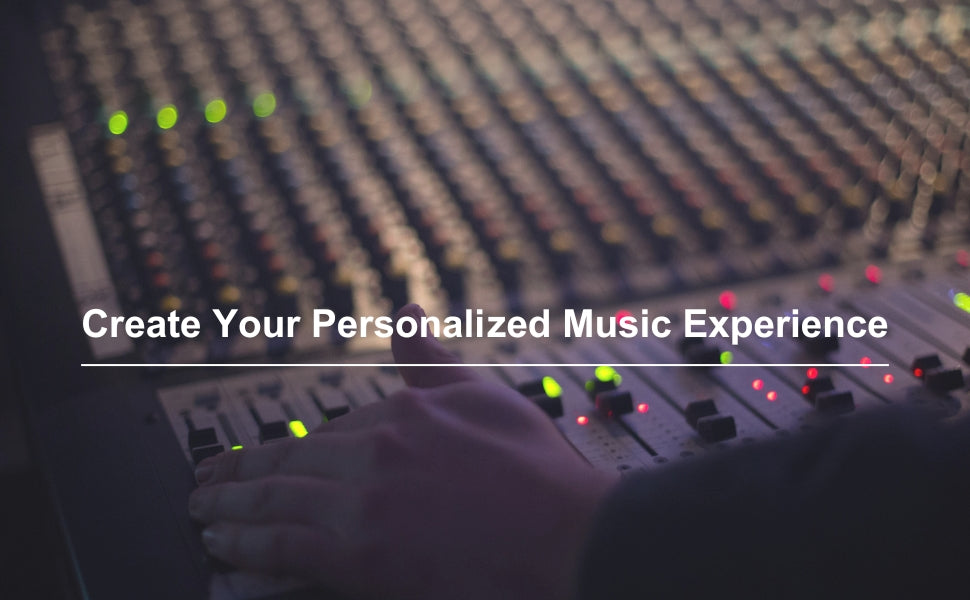
How to Adjust EQ: Create Your Personalized Music Experience
Share
Have you ever been immersed in music, only to feel like the sound quality is lacking something?
Perhaps the bass is not deep enough, the treble is too harsh, or the vocals are lacking in detail and clarity. Everyone has their own listening preferences: some people love booming bass, others prefer clear and bright treble, and some seek the balance of natural midrange frequencies. These differences are where EQ (equalizer) comes into play, offering the personalized adjustment that allows you to fine-tune your sound for the ultimate listening experience.
Imagine if your headphones or speakers could adjust the sound quality according to your unique listening style, how perfect would that be? EQ allows you to adjust the bass, midrange, and treble precisely to your liking, ensuring the ideal sound for every second of music.
In this guide, we’ll walk you through how to adjust your EQ like a sound engineer, perfectly tailored to your personal music preferences. Whether you’re a beginner or an audio enthusiast, understanding how to use EQ to optimize sound quality will be an essential skill to enhance your music experience.
1. Understanding the Role of Different Frequency Bands
First, it’s important to understand the different frequency ranges and how they affect sound quality:
Bass (20Hz - 250Hz): The bass affects the lower end of the spectrum, enhancing depth and "impact". Boosting bass can increase the "punch" of your music, but too much can result in a muddy, cluttered sound.
Midrange (250Hz - 4kHz): The midrange determines the clarity of your music, particularly for vocals and most instruments. Adjusting midrange can make music sound clearer or softer, depending on your preferences.
Treble (4kHz - 20kHz): Treble affects the brightness of your sound, and boosting treble can make the audio feel more detailed and vibrant. Reducing treble can avoid overly bright or harsh sounds.
2. Steps for Adjusting EQ
Step 1: Choose the Right Preset
Most audio devices come with preset EQ modes (such as Rock, Pop, Classical, Jazz, etc.). Try these presets first to see if any of them suit your music style. If you’re not satisfied, you can start fine-tuning manually.
Step 2: Manually Adjust the Frequency Bands
According to your music preference, adjust each frequency band:
Bass Adjustment: Boost bass (50Hz - 150Hz) for more impact in electronic or hip-hop music. Reduce bass to get a clearer, more defined sound.
Midrange Adjustment: Boost midrange (500Hz - 2kHz) to bring out vocals and guitars. Reducing midrange (1kHz - 3kHz) can help eliminate unwanted noise or harsh frequencies.
Treble Adjustment: Increase treble (4kHz - 12kHz) to bring out more clarity and detail. Reducing treble (8kHz - 16kHz) is useful for smoother sound if the highs are too sharp.
Step 3: Balance the Frequencies
Ensure that the low, mid, and high frequencies are well balanced. Over-boosting one frequency band can make the sound unnatural, so aim to maintain a smooth and balanced sound profile.

3. Common EQ Adjustment Tips & Recommendations
Adjust EQ for Specific Music Genres
Different music genres require different EQ settings:
Rock/Metal: Boost the bass (100Hz-250Hz) for strong drums and bass. Increase midrange (1kHz-3kHz) for guitars and vocals. Boost treble (6kHz-12kHz) to make the sound sharper and more vibrant.
Electronic/Dance: Strengthen bass (50Hz-100Hz) for powerful electronic bass. Enhance treble (8kHz-15kHz) to bring out the sharpness of synthetic sounds and effects.
Jazz/Classical: Slightly boost bass (50Hz-150Hz) for depth. Increase midrange (300Hz-3kHz) for more instrument detail. Add some treble (6kHz-12kHz) for added space and detail in the sound.
Adjust Based on Headphone/Speaker Characteristics
Since every audio device has its own frequency response, adjust your EQ according to the characteristics of your headphones or speakers to achieve the best sound performance:
For Overwhelming Bass: If your headphones or speakers have excessive bass, reduce the bass (50Hz-150Hz) to avoid a muddy sound.
For Sharp Highs: If the treble is too harsh, reduce treble (8kHz-12kHz) to achieve a smoother, more comfortable sound.
For Weak Midrange: If the midrange is lacking, increase midrange (1kHz-3kHz) to improve vocal and instrument clarity.
Looking for a Portable Player with Custom EQ?
If you’re looking for a portable audio player that offers customizable sound adjustments, the Surfans series players are the perfect choice. Equipped with a high-performance EQ function, these players come with both preset EQ modes and the freedom to adjust frequencies manually. Whether you want to boost the bass for an impactful experience or make vocals clearer, our players let you precisely tailor the low, mid, and high frequencies for an optimal, personalized listening experience.

4. Tips & Best Practices
Gradual Adjustments: Avoid making drastic changes to each frequency band; adjust slowly to feel the effects.
Device Limitations: Different devices can affect the EQ results, so always consider the characteristics of your equipment.
Ear Adaptation: Over time, your ears may adapt to certain frequencies. Occasionally readjust your EQ to keep the sound fresh and enjoyable.
Summary: The Power of Sound Customization in Your Hands
In the world of music, every tweak to the sound can influence your emotions and experience. EQ is the bridge between you and your audio device, allowing you to find the sound that fits your listening preferences. By adjusting bass, midrange, and treble, you can effortlessly enhance the sound quality and enjoy a more personalized and immersive listening experience. Whether you’re using preset modes or fine-tuning manually, EQ helps you bring the music to life, making every track perfectly suited to your ears.
